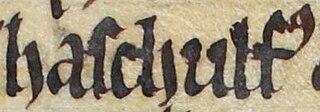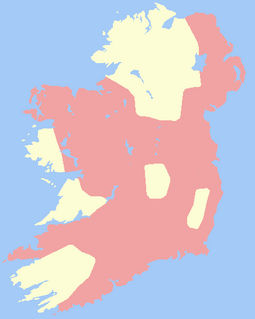| |||||
| Centuries: | |||||
|---|---|---|---|---|---|
| Decades: | |||||
| See also: | Other events of 1170 List of years in Ireland | ||||
Events from the year 1170 in Ireland.
| |||||
| Centuries: | |||||
|---|---|---|---|---|---|
| Decades: | |||||
| See also: | Other events of 1170 List of years in Ireland | ||||
Events from the year 1170 in Ireland.

Dublin is the capital and largest city of Ireland. Situated on a bay on the east coast, at the mouth of the River Liffey, it lies within the province of Leinster. It is bordered on the south by the Dublin Mountains, a part of the Wicklow Mountains range. It has an urban area population of 1,173,179, while the population of the Dublin Region as of 2016 was 1,347,359. The population of the Greater Dublin Area was 1,904,806 per the 2016 census.

Ascall mac Ragnaill meic Torcaill, also known as Ascall Mac Torcaill, was the last Norse-Gaelic King of Dublin. He was a member of the Meic Torcaill, a Dublin family of significance since the early twelfth century.
Richard de Clare, 2nd Earl of Pembroke, Lord of Leinster, Justiciar of Ireland was an Anglo-Norman nobleman notable for his leading role in the Anglo-Norman invasion of Ireland. Like his father, Richard fitz Gilbert has since become commonly known by his nickname Strongbow, which may be a mistranscription or mistranslation of "Striguil."
Year 1171 (MCLXXI) was a common year starting on Friday of the Julian calendar.

The Lordship of Ireland, sometimes referred to retroactively as Norman Ireland, was the part of Ireland ruled by the King of England and controlled by loyal Anglo-Norman lords between 1177 and 1542. The lordship was created as a Papal fief following the Norman invasion of Ireland in 1169–1171. As the lord of Ireland was also the king of England, he was represented locally by a governor, variously known as justiciar, lieutenant, or Lord Deputy.

Dunamase or The Rock of Dunamase is a rocky outcrop in the townland of Park or Dunamase in County Laois. The rock, 46 metres (151 ft) above a flat plain, has the ruins of Dunamase Castle, a defensive stronghold dating from the early Hiberno-Norman period with a view across to the Slieve Bloom Mountains. It is near the N80 road between the towns of Portlaoise and Stradbally.
Diarmait Mac Murchada, anglicised as Dermot MacMurrough, Dermod MacMurrough, or Dermot MacMorrogh, was a King of Leinster in Ireland. In 1167, he was deposed by the High King of Ireland – Ruaidri Ua Conchobair. The grounds for the deposition were that Mac Murchada had, in 1152, abducted Derbforgaill, the wife of the King of Breifne, Tiernan O'Rourke. To recover his kingdom, Mac Murchada solicited help from King Henry II of England. His issue unresolved, he gained the military support of the Earl of Pembroke. At that time, Strongbow was in opposition to Henry II due to his support for Stephen, King of England against Henry's mother in The Anarchy. In exchange for his aid, Strongbow was promised in marriage to Mac Murchada's daughter Aoife with the right to succeed to the Kingship of Leinster. Henry II then mounted a larger second invasion in 1171 to ensure his control over Strongbow, resulting in the Norman Lordship of Ireland. Mac Murchada was later known as Diarmait na nGall.

Lorcán Ua Tuathail, also known as Saint Laurence O'Toole, was Archbishop of Dublin at the time of the Norman invasion of Ireland. He played a prominent role in the Irish Church Reform Movement of the 12th century and mediated between the parties during and after the invasion. He was canonised in 1225 by Pope Honorius III.

The Book of Leinster, is a medieval Irish manuscript compiled ca. 1160 and now kept in Trinity College, Dublin, under the shelfmark MS H 2.18. It was formerly known as the Lebor na Nuachongbála "Book of Nuachongbáil", a monastic site known today as Oughaval.
The Song of Dermot and the Earl is an anonymous Anglo-Norman verse chronicle written in the early 13th century in England. It tells of the arrival of Strongbow in Ireland in 1170, and of the subsequent arrival of Henry II of England.

RaymondFitzGerald, nicknamed Le Gros, was a Cambro-Norman commander during the Norman invasion of Ireland. Raymond was among the first of a small band of Norman knights who landed on the South coast of Ireland before being reinforced by a larger force led by Richard de Clare, 2nd Earl of Pembroke. He was active consolidating Norman rule over Ireland before he retired to his estates in Waterford where he died in the late 12th century.
Tighearnán Mór Ua Ruairc, anglicised as Tiernan O'Rourke ruled the Kingdom of Bréifne as the 19th king in its Ua Ruairc dynasty, a branch of the Uí Briúin. He was a descendant of Ui Riagain, and one of the provincial kings in Ireland in the twelfth century, constantly expanding his kingdom through shifting alliances, of which the most long-standing was with Toirdelbach Ua Conchobair King of Connacht and High King of Ireland, and subsequently his son and successor Ruaidhri Ua Conchobair. He is known for his role in the expulsion of Diarmait Mac Murchada, King of Leinster, from Ireland in 1166. Mac Murchada's subsequent recruitment of Marcher Lords to assist him in the recovery of his Kingdom of Leinster ultimately led to the Norman invasion of Ireland.

The Norman invasion of Ireland took place in stages during the late 12th century and led to the Anglo-Normans conquering large swathes of land from the Irish. At the time, Gaelic Ireland was made up of several kingdoms, with a High King claiming lordship over the lesser kings. The Norman invasion was a watershed in the history of Ireland, marking the beginning of more than 800 years of direct English and, later, British involvement in Ireland.

Aoife MacMurrough, also known by later historians as Eva of Leinster, was an Irish noble, princess of Leinster and countess of Pembroke. She was the daughter of Dermot MacMurrough, King of Leinster and his second wife, Mór Ní Tuathail or Mor O'Toole, and a niece of Archbishop of Dublin St Lawrence O'Toole.

Dublin: Foundation (2004) is a novel by Edward Rutherfurd first published in 2004 by Century Hutchinson and then by Seal Books and Doubleday Canada.
Events from the year 1176 in Ireland.
Events from the year 1142 in Ireland.
Events from the year 1169 in Ireland.
Events from the year 1171 in Ireland.
Mór Ní Thuathail was a Queen-consort of Leinster as the principal first wife of King Diarmait Mac Murchada. Under Brehon Law, Irish men were allowed more than one wife. King Dermot's second wife was Sadhbh Ní Fhaolain.
Events from the year 1167 in Ireland.
Siege of Dublin was an unsuccessful attempt of the last high king of Ireland, Ruaidrí Ua Conchobair to capture the City of Dublin from the English in 1171.